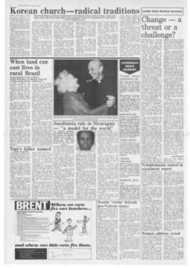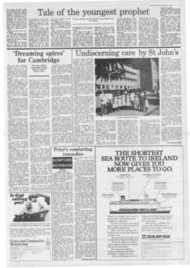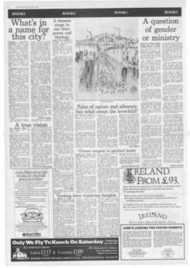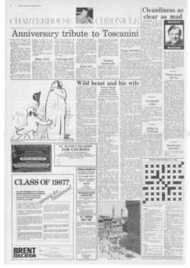Page 7, 26th June 1987
Page 7
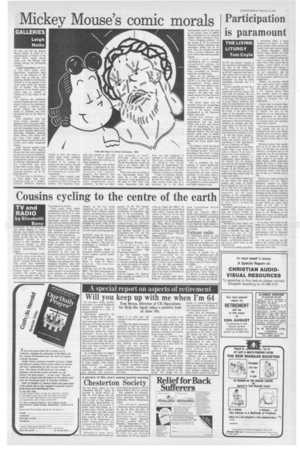
Report an error
Noticed an error on this page?If you've noticed an error in this article please click here to report it.
Tags
Share
Related articles
Taking Mickey Mouse To Bed
Carry Coal Up Five Floors?
Williamson A Pattern Prince
The Creator Of Mickey Mouse
Convinced Of Origina Sin By
Mickey
Mouse's comic morals•
GALLERIES
Leigh Hatts
IN Italy you can see Mickey Mouse almost as often as a representation of Christ or the Virgin Mary. Some church shops even sell Mickey wall plaques among the christening presents.
Comic Iconoclasm at the ICA in The Mall (daily until September, admission 60p) looks at the influence of the comic strip on fine art. One painting, Dublin by Ed Ruscha, reminds is of the appeal of the comic strip which has become part of Sunday. Two folded fragments of the Sunday paper comics page so popular in Ireland are in the centre of the canvas.
In America the syndicated Funnies Supplement has a much greater hold on the population and recently a pull-out strip section (clearly not entirely aimed at children) has been introduced here by the Mail on Sunday.
Steve Gianakos' Lulu and Jesus brings together two popular icons of the early 1980s. But Lulu, who also lives on, may now be recognised more often than Jesus. Another much more disturbing Gianakos painting shows Hitler, who along with the Coca Cola badge and Mickey Mouse top the list of the world's most easily recognised images.
Andy Warhol painted both Marilyn Monroe and Mickey Mouse who have now wandered far from the arena of childhood. Artists have him seen in strange schizophrenic guises: a pastiche of abstract expressionism with Roy Lichtenstein and even incised with a razor blade as a tattoo on an artist's back. The powerful influence can be for good and evil.
The first work in the show is by Peter Blake who, after producing strips as a student, painted Children Reading Comics in 1954. The comic is clearly Eagle which Anglican priest Marcus Morris had founded in an attempt to harness the new icons to the old Christian message. Dan Dare became so powerful that today he is appearing in a current ITV commercial.
Clark's Shoes recently used Warhol's version of Dick Tracy to advertise stylish footwear for children. The American Tracy strip was created in 1931 and featured a good detective fighting crime and insisting on moral standards.
Ronnie Cutrone, who studied theology, is represented by two paintings which integrate media characters with religious imagery. He believes that Woody Woodpecker and the Pink Panther have a potential to make unequivocal moral statements "as they are taken very seriously as icons" although "they are just cartoons". He notes that in Woody Woodpecker stories the state is not always right but Woody always triumphs in the end.
Thirty years after the axing of the long-running Krazy Kat series he is still appearing sprayed by a new generation on the sides of New York tube trains. Meanwhile Tom and Jerry are now employed in warning of the nuclear threat. This is not a comics exhibition for children who would probably be disappointed, but families will enjoy the Asterix films being shown in the ICA Children's Cinema at weekends.
"I ask it to astonish, disturb, seduce and convince" might be the test for a comic strip. This is what Lucien Freud asks of a painting. He is the third
distinguished artist to take part in the present series of Artist's
Eye exhibitions at the National Gallery (daily; admission free). "Like a burgling collector" he has chosen 27 of his favourite National Gallery paintings and reluctantly added two of his
own. One, his Double Portrait from a private collection, has never before been seen on public display.
Freud's work eludei classification but is instantly recognisable among the Velazquez, Constable, Degas and Cezanne which have been hung according to Freud's particular juxtapositions.
There are no captions or explanations and the catalogue (£2.95) is no more than bound reproductions. Freud merely says: "I have been asked to give reasons for my choice. The paintings themselves are the reasons." He adds that "the uneasy silence of a man faced by a work of art is unlike any other."
No doubt more will be revealed about the increasingly uncommunicative artist when there is the major Freud retrospective at the Hayward Gallery next year.
Freud has chosen six Rembrandts, including The Lamentation over the Dead Christ, but a less well known work by Rembrandt has just
gone on show elsewhere in the National Gallery. The new tiny picture, never seen in public before and almost lost among the larger frames in Room 26, is Daniel and Cyrus before Idol Be!.
The subject is from the Book of Daniel and shows Daniel at the moment he says: "Let it be according to thy word" to King Cyrus as he points with a sceptre to the food and wine laid out for the idol.
This is probably the last painting in which Rembrandt
employed the small scale precision detail which characterised his early history paintings. In the same room is the huge Belshazzar 's Feast, dated only two years on in 1635 but painted in a more colourful and highly dramatic style.
blog comments powered by Disqus



